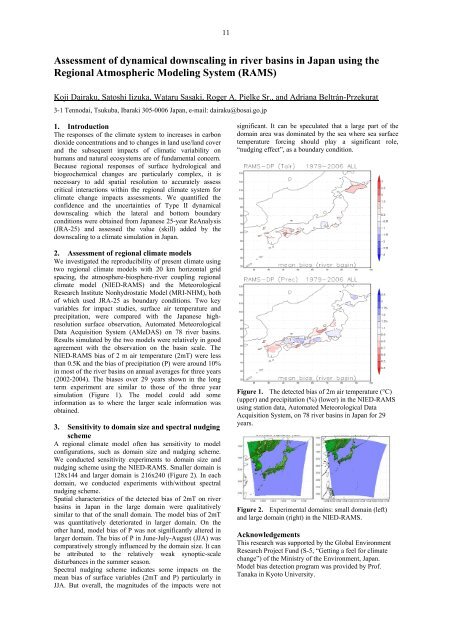Low (web) Quality - BALTEX
Low (web) Quality - BALTEX
Low (web) Quality - BALTEX
You also want an ePaper? Increase the reach of your titles
YUMPU automatically turns print PDFs into web optimized ePapers that Google loves.
11<br />
Assessment of dynamical downscaling in river basins in Japan using the<br />
Regional Atmospheric Modeling System (RAMS)<br />
Koji Dairaku, Satoshi Iizuka, Wataru Sasaki, Roger A. Pielke Sr., and Adriana Beltrán-Przekurat<br />
3-1 Tennodai, Tsukuba, Ibaraki 305-0006 Japan, e-mail: dairaku@bosai.go.jp<br />
1. Introduction<br />
The responses of the climate system to increases in carbon<br />
dioxide concentrations and to changes in land use/land cover<br />
and the subsequent impacts of climatic variability on<br />
humans and natural ecosystems are of fundamental concern.<br />
Because regional responses of surface hydrological and<br />
biogeochemical changes are particularly complex, it is<br />
necessary to add spatial resolution to accurately assess<br />
critical interactions within the regional climate system for<br />
climate change impacts assessments. We quantified the<br />
confidence and the uncertainties of Type II dynamical<br />
downscaling which the lateral and bottom boundary<br />
conditions were obtained from Japanese 25-year ReAnalysis<br />
(JRA-25) and assessed the value (skill) added by the<br />
downscaling to a climate simulation in Japan.<br />
2. Assessment of regional climate models<br />
We investigated the reproducibility of present climate using<br />
two regional climate models with 20 km horizontal grid<br />
spacing, the atmosphere-biosphere-river coupling regional<br />
climate model (NIED-RAMS) and the Meteorological<br />
Research Institute Nonhydrostatic Model (MRI-NHM), both<br />
of which used JRA-25 as boundary conditions. Two key<br />
variables for impact studies, surface air temperature and<br />
precipitation, were compared with the Japanese highresolution<br />
surface observation, Automated Meteorological<br />
Data Acquisition System (AMeDAS) on 78 river basins.<br />
Results simulated by the two models were relatively in good<br />
agreement with the observation on the basin scale. The<br />
NIED-RAMS bias of 2 m air temperature (2mT) were less<br />
than 0.5K and the bias of precipitation (P) were around 10%<br />
in most of the river basins on annual averages for three years<br />
(2002-2004). The biases over 29 years shown in the long<br />
term experiment are similar to those of the three year<br />
simulation (Figure 1). The model could add some<br />
information as to where the larger scale information was<br />
obtained.<br />
3. Sensitivity to domain size and spectral nudging<br />
scheme<br />
A regional climate model often has sensitivity to model<br />
configurations, such as domain size and nudging scheme.<br />
We conducted sensitivity experiments to domain size and<br />
nudging scheme using the NIED-RAMS. Smaller domain is<br />
128x144 and larger domain is 216x240 (Figure 2). In each<br />
domain, we conducted experiments with/without spectral<br />
nudging scheme.<br />
Spatial characteristics of the detected bias of 2mT on river<br />
basins in Japan in the large domain were qualitatively<br />
similar to that of the small domain. The model bias of 2mT<br />
was quantitatively deteriorated in larger domain. On the<br />
other hand, model bias of P was not significantly altered in<br />
larger domain. The bias of P in June-July-August (JJA) was<br />
comparatively strongly influenced by the domain size. It can<br />
be attributed to the relatively weak synoptic-scale<br />
disturbances in the summer season.<br />
Spectral nudging scheme indicates some impacts on the<br />
mean bias of surface variables (2mT and P) particularly in<br />
JJA. But overall, the magnitudes of the impacts were not<br />
significant. It can be speculated that a large part of the<br />
domain area was dominated by the sea where sea surface<br />
temperature forcing should play a significant role,<br />
“nudging effect”, as a boundary condition.<br />
Figure 1. The detected bias of 2m air temperature (°C)<br />
(upper) and precipitation (%) (lower) in the NIED-RAMS<br />
using station data, Automated Meteorological Data<br />
Acquisition System, on 78 river basins in Japan for 29<br />
years.<br />
Figure 2. Experimental domains: small domain (left)<br />
and large domain (right) in the NIED-RAMS.<br />
Acknowledgements<br />
This research was supported by the Global Environment<br />
Research Project Fund (S-5, “Getting a feel for climate<br />
change”) of the Ministry of the Environment, Japan.<br />
Model bias detection program was provided by Prof.<br />
Tanaka in Kyoto University.













